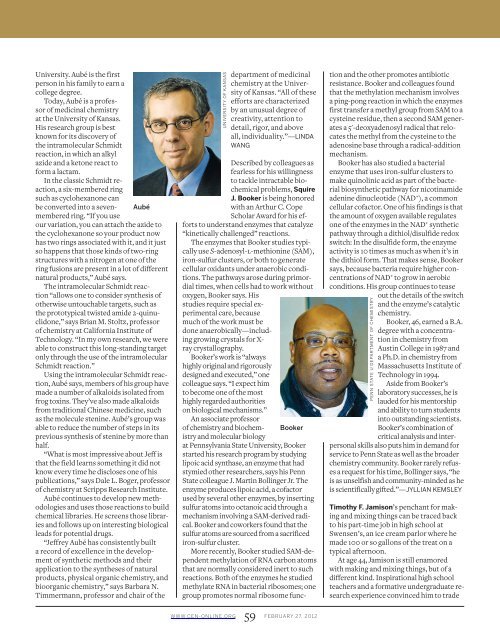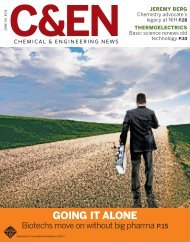February 27, 2012 - IMM@BUCT
February 27, 2012 - IMM@BUCT
February 27, 2012 - IMM@BUCT
Create successful ePaper yourself
Turn your PDF publications into a flip-book with our unique Google optimized e-Paper software.
University. Aubé is the first<br />
person in his family to earn a<br />
college degree.<br />
Today, Aubé is a professor<br />
of medicinal chemistry<br />
at the University of Kansas.<br />
His research group is best<br />
known for its discovery of<br />
the intramolecular Schmidt<br />
reaction, in which an alkyl<br />
azide and a ketone react to<br />
form a lactam.<br />
In the classic Schmidt reaction,<br />
a six-membered ring<br />
such as cyclohexanone can<br />
be converted into a sevenmembered<br />
ring. “If you use<br />
Aubé<br />
our variation, you can attach the azide to<br />
the cyclohexanone so your product now<br />
has two rings associated with it, and it just<br />
so happens that those kinds of two-ring<br />
structures with a nitrogen at one of the<br />
ring fusions are present in a lot of different<br />
natural products,” Aubé says.<br />
The intramolecular Schmidt reaction<br />
“allows one to consider synthesis of<br />
otherwise untouchable targets, such as<br />
the prototypical twisted amide 2-quinuclidone,”<br />
says Brian M. Stoltz, professor<br />
of chemistry at California Institute of<br />
Technology. “In my own research, we were<br />
able to construct this long-standing target<br />
only through the use of the intramolecular<br />
Schmidt reaction.”<br />
Using the intramolecular Schmidt reaction,<br />
Aubé says, members of his group have<br />
made a number of alkaloids isolated from<br />
frog toxins. They’ve also made alkaloids<br />
from traditional Chinese medicine, such<br />
as the molecule stenine. Aubé’s group was<br />
able to reduce the number of steps in its<br />
previous synthesis of stenine by more than<br />
half.<br />
“What is most impressive about Jeff is<br />
that the field learns something it did not<br />
know every time he discloses one of his<br />
publications,” says Dale L. Boger, professor<br />
of chemistry at Scripps Research Institute.<br />
Aubé continues to develop new methodologies<br />
and uses those reactions to build<br />
chemical libraries. He screens those libraries<br />
and follows up on interesting biological<br />
leads for potential drugs.<br />
“Jeffrey Aubé has consistently built<br />
a record of excellence in the development<br />
of synthetic methods and their<br />
application to the syntheses of natural<br />
products, physical organic chemistry, and<br />
bioorganic chemistry,” says Barbara N.<br />
Timmermann, professor and chair of the<br />
UNIVERSITY OF KANSAS<br />
Described by colleagues as<br />
fearless for his willingness<br />
to tackle intractable biochemical<br />
problems, Squire<br />
J. Booker is being honored<br />
with an Arthur C. Cope<br />
Scholar Award for his efforts<br />
to understand enzymes that catalyze<br />
“kinetically challenged” reactions.<br />
The enzymes that Booker studies typically<br />
use S-adenosyl-l-methionine (SAM),<br />
iron-sulfur clusters, or both to generate<br />
cellular oxidants under anaerobic conditions.<br />
The pathways arose during primordial<br />
times, when cells had to work without<br />
oxygen, Booker says. His<br />
studies require special experimental<br />
care, because<br />
much of the work must be<br />
done anaerobically—including<br />
growing crystals for X-<br />
ray crystallography.<br />
Booker’s work is “always<br />
highly original and rigorously<br />
designed and executed,” one<br />
colleague says. “I expect him<br />
to become one of the most<br />
highly regarded authorities<br />
on biological mechanisms.”<br />
An associate professor<br />
of chemistry and biochemistry<br />
and molecular biology<br />
department of medicinal<br />
chemistry at the University<br />
of Kansas. “All of these<br />
efforts are characterized<br />
by an unusual degree of<br />
creativity, attention to<br />
detail, rigor, and above<br />
all, individuality.” —LINDA<br />
WANG<br />
Booker<br />
at Pennsylvania State University, Booker<br />
started his research program by studying<br />
lipoic acid synthase, an enzyme that had<br />
stymied other researchers, says his Penn<br />
State colleague J. Martin Bollinger Jr. The<br />
enzyme produces lipoic acid, a cofactor<br />
used by several other enzymes, by inserting<br />
sulfur atoms into octanoic acid through a<br />
mechanism involving a SAM-derived radical.<br />
Booker and coworkers found that the<br />
sulfur atoms are sourced from a sacrificed<br />
iron-sulfur cluster.<br />
More recently, Booker studied SAM-dependent<br />
methylation of RNA carbon atoms<br />
that are normally considered inert to such<br />
reactions. Both of the enzymes he studied<br />
methylate RNA in bacterial ribosomes; one<br />
group promotes normal ribosome func-<br />
tion and the other promotes antibiotic<br />
resistance. Booker and colleagues found<br />
that the methylation mechanism involves<br />
a ping-pong reaction in which the enzymes<br />
first transfer a methyl group from SAM to a<br />
cysteine residue, then a second SAM generates<br />
a 5'-deoxyadenosyl radical that relocates<br />
the methyl from the cysteine to the<br />
adenosine base through a radical-addition<br />
mechanism.<br />
Booker has also studied a bacterial<br />
enzyme that uses iron-sulfur clusters to<br />
make quinolinic acid as part of the bacterial<br />
biosynthetic pathway for nicotinamide<br />
adenine dinucleotide (NAD + ), a common<br />
cellular cofactor. One of his findings is that<br />
the amount of oxygen available regulates<br />
one of the enzymes in the NAD + synthetic<br />
pathway through a dithiol/disulfide redox<br />
switch: In the disulfide form, the enzyme<br />
activity is 10 times as much as when it’s in<br />
the dithiol form. That makes sense, Booker<br />
says, because bacteria require higher concentrations<br />
of NAD + to grow in aerobic<br />
conditions. His group continues to tease<br />
out the details of the switch<br />
and the enzyme’s catalytic<br />
chemistry.<br />
Booker, 46, earned a B.A.<br />
degree with a concentration<br />
in chemistry from<br />
Austin College in 1987 and<br />
a Ph.D. in chemistry from<br />
Massachusetts Institute of<br />
Technology in 1994.<br />
Aside from Booker’s<br />
laboratory successes, he is<br />
lauded for his mentorship<br />
and ability to turn students<br />
into outstanding scientists.<br />
Booker’s combination of<br />
critical analysis and interpersonal<br />
skills also puts him in demand for<br />
service to Penn State as well as the broader<br />
chemistry community. Booker rarely refuses<br />
a request for his time, Bollinger says, “he<br />
is as unselfish and community-minded as he<br />
is scientifically gifted.” —JYLLIAN KEMSLEY<br />
PENN STATE U DEPARTMENT OF CHEMISTRY<br />
Timothy F. Jamison’s penchant for making<br />
and mixing things can be traced back<br />
to his part-time job in high school at<br />
Swensen’s, an ice cream parlor where he<br />
made 100 or so gallons of the treat on a<br />
typical afternoon.<br />
At age 44, Jamison is still enamored<br />
with making and mixing things, but of a<br />
different kind. Inspirational high school<br />
teachers and a formative undergraduate research<br />
experience convinced him to trade<br />
WWW.CEN-ONLINE.ORG 59 FEBRUARY <strong>27</strong>, <strong>2012</strong>

















